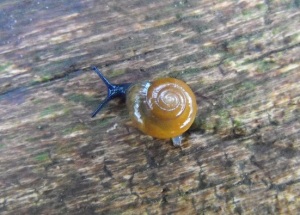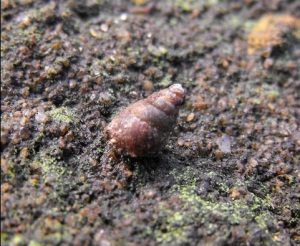The first full week of 2015 is over, so I thought it best to review how my snail quest is progressing.
Yesterday, I was invited to speak briefly on BBC Three Counties radio. I got a decent plug of my Twitter page, but other than that the conversation was a little awkward; the host’s questions mainly revolving around either eating snails, or using them in beauty treatments. Also, I’m not from Bedfordshire, I just live there (here) at present.
I also sensed that the host was a touch underwhelmed with my current snail total of four species. Well, it’s only been ten days; what does he expect? I mean, I could have gone out on the first of January – or indeed today – and probably yielded ten species or so, but it’s not meant to be a race. I want to share each species that I find with my followers on Twitter and give each species due attention.
Anyway, let’s have a roundup of the snails I’ve seen in the past ten days.
Vitrina pellucida, Winter Semi-slug or Pellucid Glass Snail
A common and widespread species, easily found in disturbed habitats such as gardens, wasteland and brownfield sites. It is usually found as an adult during the winter months, hence one of its common names ‘The Winter Semi-slug’. The ‘semi-slug’ part of the name refers to the way that the body of the snail wraps over part of the thin, translucent shell, giving it appearance that could be considered intermediate between slugs and snails. I’ve found multiple examples of this species so far, with the pictured example below found in a garden in Hull.
Lauria cylindracea, Common Chrysalis Snail
Another very common and widespread species, but usually overlooked. I’ve probably found more than fifty of these so far this year, but when I show people the most common response is: “Wow, I’ve never seen a snail so small before!” At a maximum of 4.4mm tall (and usually smaller) that’s understandable. If turning over rocks or stones, have a really close look at the underside. Lauria cylindracea is often present.
Oxychilus alliarius, Garlic Snail
This snail is a real crowd-pleaser. A garlic snail, when disturbed, produces a strong garlic-scented odour, hence both the common and scientific appellations. It is not the only snail to produce a garlic aroma when bothered; its close congener Oxychilus navarricus does something similar but with a weaker and less pungent scent. Later in the year, once I have found a specimen of O. navarricus, I will run through how to differentiate them.
Merdigera obscura, Lesser Bulin
I must confess to not knowing what the common name of this species means; what exactly is a ‘bulin’? The scientific name, unusually, is easier to understand, ‘merdigera’ meaning ‘excrement bearer’ and ‘obscura’ meaning ‘hidden’. Essentially, a snail hidden by its own excrement. The species bears this name because of its habit of coating its shell in dirt, faeces and algae – possibly for reasons of camouflage? You can see that the shell in my, frankly underwhelming, photo below has some matter adhering to it.
So those are my first four species of 2015. If I carry on at this rate – four species in ten days – I shall just about achieve seeing all the UK species by the end of the year.
If you’re not following me on Twitter, please consider doing so @UKSnailTrail. If you find any snails and take any photographs then please share them with me and my followers on there – we’d love to see them.
For further, more in-depth information on snails and other molluscs, please check out the website of the Conchological Society of Great Briatin and Ireland.



